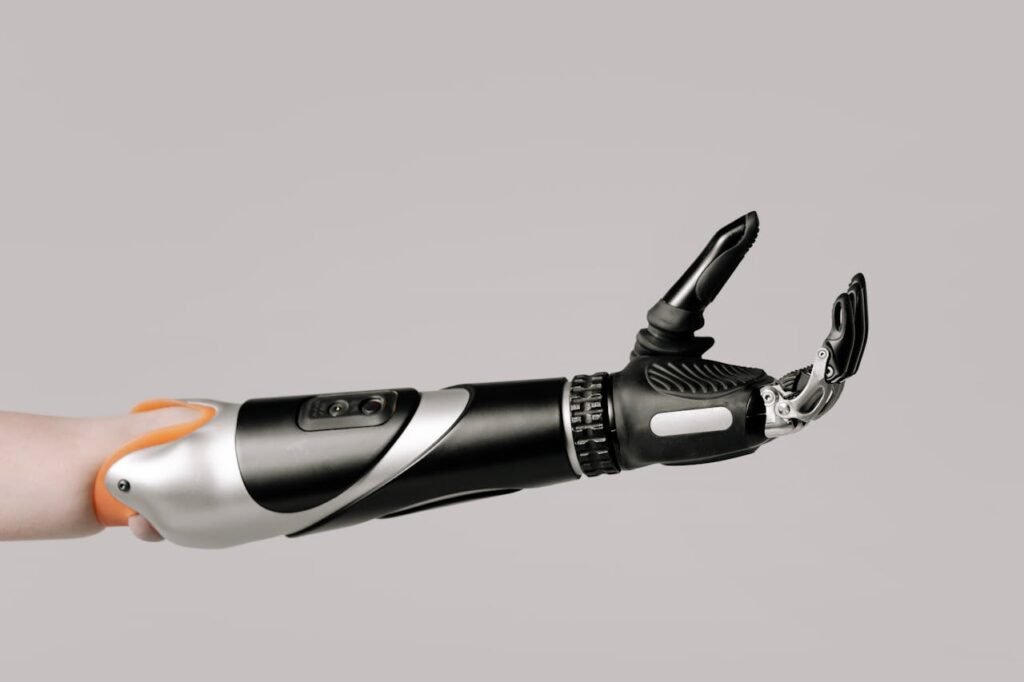When you lose part of your hand, it’s not just the shape that changes—it’s the way your muscles and nerves work together. Even with a prosthetic finger, some people find that their grip is weaker or less precise than they’d like.
That’s where EMS—Electrical Muscle Stimulation—comes in. It’s a method that uses gentle electrical pulses to activate muscles, helping them get stronger and work more efficiently.
Now, experts and users alike are asking: can combining EMS with finger prosthetics make grip control even better? Could it help people not just hold things, but hold them with more stability, strength, and confidence?
In this article, we’ll explore what EMS is, how it works with prosthetics, the potential benefits, and what early experiences tell us. We’ll also share how Robobionics is looking at this technology for the future of grip enhancement.
Understanding Grip Control in Finger Prosthetics
How a Natural Grip Works
In a natural hand, grip control is a beautiful coordination between the brain, nerves, and muscles. Your brain sends signals through your nerves, telling your muscles exactly how much to contract. This decides whether you hold a delicate teacup gently or a hammer firmly.
Your fingers adjust their position automatically based on feedback from touch sensors in your skin. This constant back-and-forth communication makes your grip both strong and adaptable.
The Challenge After Limb Loss
When someone loses a finger or part of a hand, the direct path for these signals changes. The brain may still try to send instructions, but the muscles and nerves that used to work together are no longer in the same way.
Even with a high-quality prosthetic finger, some users find it hard to judge how much force to apply. This can lead to two problems:
- Holding too lightly and dropping things
- Holding too tightly and damaging fragile objects
How Prosthetics Restore Grip
Finger prosthetics—especially mechanical and myoelectric types—try to replicate the natural grip by translating muscle activity into movement.
In mechanical devices, movements are often controlled by simple body-powered systems. In myoelectric devices, sensors read muscle signals and turn them into finger movement.
The better the muscle signals, the better the prosthetic responds. This is where muscle strength, endurance, and coordination play a huge role.
The Missing Link: Muscle Conditioning
One challenge for prosthetic users is that after an injury or surgery, the remaining muscles in the arm or hand may weaken from lack of use. Even if the prosthetic itself works perfectly, weak or untrained muscles can limit performance.
This is where EMS might offer a new advantage—helping to strengthen and train the muscles that control the prosthetic, improving the quality of grip control over time.
What EMS Is and How It Works for Prosthetic Users
What Exactly Is EMS?
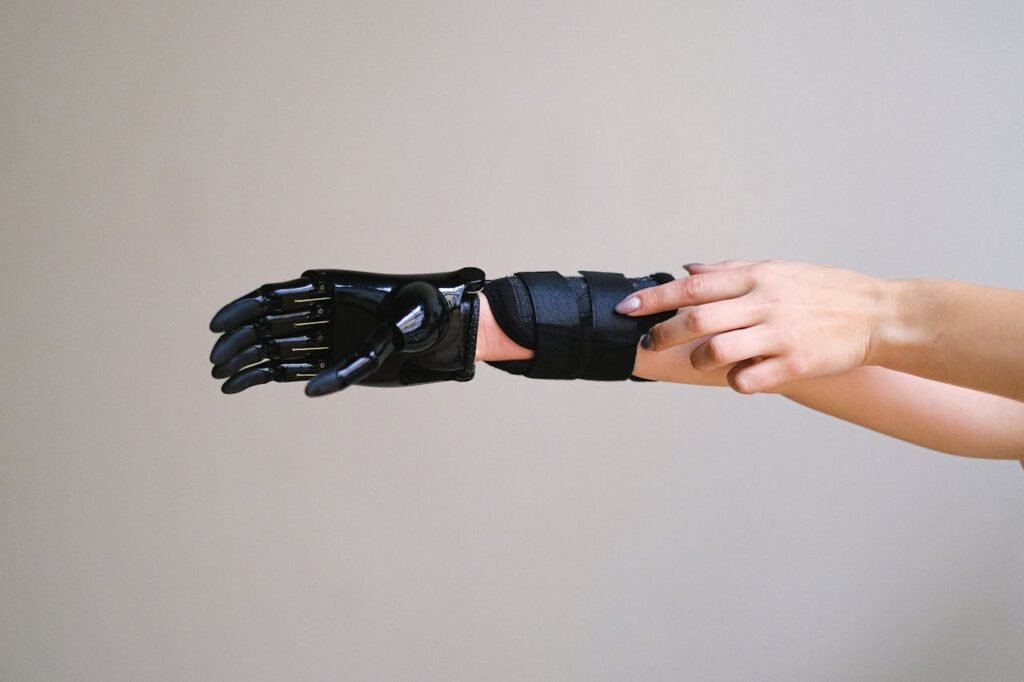
EMS stands for Electrical Muscle Stimulation. It’s a method that uses gentle electrical impulses to make muscles contract. These impulses are delivered through small pads placed on the skin, right over the targeted muscles.
The electrical signal from an EMS device is similar to the natural signal your brain sends through your nerves. When your muscles receive this signal, they respond by tightening and relaxing, just as they would during regular movement.
It’s a safe and well-researched method, used for years in physiotherapy, sports training, and muscle recovery.
Why EMS Is Different from Regular Exercise
When you exercise normally—say, by lifting a weight—your brain decides how many muscle fibers to activate. Often, it doesn’t use all of them at once.
EMS can bypass that limitation. Because it directly stimulates the muscle, it can activate more fibers at once, even ones that might not normally engage during light exercise. This makes EMS especially useful for rehabilitation, where certain muscles may have become “lazy” after injury.
For prosthetic users, this is important because muscles around the wrist, forearm, or residual limb can become underused if they aren’t actively involved in daily movements.
How EMS Helps Muscle Recovery After Limb Loss
After losing a finger or part of a hand, the muscles in the surrounding area often lose strength and coordination. Some might even shrink from lack of use—a process called muscle atrophy.
Without enough muscle strength, a prosthetic can feel harder to control. The device may respond slowly or with less accuracy, simply because the input signals from the muscles are weak.
EMS can help by:
- Stimulating muscle contractions without requiring heavy effort from the user
- Increasing blood flow to speed up recovery
- Re-training the brain-muscle connection so signals become clearer
How EMS Fits with Myoelectric Prosthetics
Myoelectric prosthetics work by reading electrical signals from the user’s muscles through sensors in the socket or cuff.
If the muscles are weak, these signals might be too faint for the prosthetic to pick up accurately. That can lead to delayed or jerky movements.
By using EMS to strengthen these muscles, the signal quality improves. This means the prosthetic responds faster and more smoothly to the user’s commands.
Think of it like tuning an instrument—EMS helps make the “notes” (muscle signals) stronger and clearer so the prosthetic can “play” them accurately.
Using EMS with Mechanical Prosthetics
Even with mechanical or body-powered prosthetics, muscle strength matters. These devices rely on the user’s movement and force to operate cables, hinges, or joints.
If the muscles are stronger and better conditioned, the user can operate the device more efficiently and with less fatigue. EMS training can build this strength without putting too much strain on healing tissues during early recovery.
A Day in the Life with EMS Training
Imagine a farmer from rural India who uses a partial finger prosthetic to hold tools. During the day, he works with his device as usual. In the evening, he spends 20 minutes using an EMS unit on his forearm muscles.
Over weeks, the combination of real-world use and EMS training strengthens the muscles involved in gripping. The prosthetic starts responding more naturally—tools feel easier to hold, and there’s less strain by the end of the day.
This is how EMS complements real-life prosthetic use, turning every day into both a working and a training session.
Safety and Comfort of EMS
EMS is generally safe when used properly and under guidance. The intensity can be adjusted so that the contractions are firm but not painful. For most people, it feels like a gentle tingling followed by a tightening of the muscle.
However, certain precautions are important:
- It should not be used over open wounds or areas with skin irritation
- People with pacemakers or certain heart conditions should avoid EMS unless cleared by a doctor
- It should be used in short, controlled sessions rather than for hours at a time
In a prosthetic training context, EMS would typically be supervised by a physiotherapist at first, then continued at home once the user is confident.
EMS Devices in the Indian Context
In India, EMS is still better known among athletes and physiotherapists than among prosthetic users. But the technology is becoming more affordable, with portable EMS units available at reasonable prices.
At Robobionics, we see potential in combining EMS with our own prosthetic training programs—especially for rural users who can’t easily travel for frequent physiotherapy sessions. With the right guidance, a simple EMS kit could become a powerful home tool for building grip strength.
The Link Between EMS and Grip Control
Grip control isn’t just about having strong muscles—it’s about having muscles that respond quickly and accurately to signals from the brain.
When EMS is used regularly, it can:
- Wake up inactive muscle fibers
- Improve reaction time
- Increase endurance for repetitive tasks
- Make signals more consistent for myoelectric sensors
The result? More stability when holding objects, smoother motion when moving from open to closed grip, and less unintentional dropping or crushing of items.
Early Observations from EMS-Prosthetic Combinations
While large-scale studies are still limited, early case experiences suggest promising results. Prosthetic users who added EMS to their training reported:
- Easier control during delicate tasks like picking up small objects
- Less fatigue when holding heavier items for long periods
- More confidence in public, as they felt less likely to fumble or drop things
For Robobionics, these stories are enough to keep exploring how EMS can become a standard part of prosthetic adaptation programs.
How to Integrate EMS into Finger Prosthetic Training
Step 1: Get a Professional Assessment
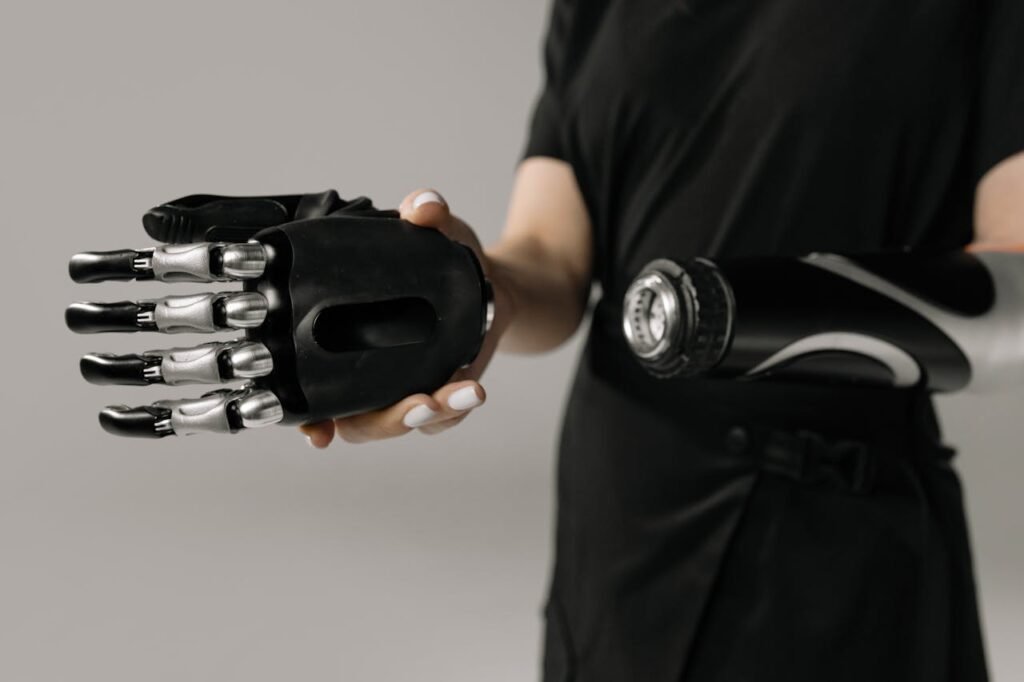
Before starting any EMS program, it’s important to know which muscles will benefit most. A prosthetist or physiotherapist can identify the exact muscle groups that control your prosthetic finger movements.
For example:
- If you have a myoelectric prosthetic, the focus may be on the forearm flexor and extensor muscles.
- If you have a mechanical prosthetic, the focus might be on the wrist and hand stump muscles that generate cable or hinge movement.
This initial assessment ensures you’re targeting the right muscles for grip improvement.
Step 2: Choose the Right EMS Device
In India, EMS devices range from hospital-grade machines to portable home units. For most prosthetic users, a small, battery-operated EMS machine with adjustable intensity is enough.
Key things to look for:
- Adjustable frequency and pulse settings
- Comfortable, reusable electrode pads
- A simple interface that doesn’t require technical knowledge
- Durability for daily or weekly use
Some physiotherapy clinics may also rent EMS units for home use, which can be a budget-friendly option.
Step 3: Learn Proper Pad Placement
The placement of EMS pads is crucial. They should be positioned over the muscle belly (the thickest part of the muscle) for effective contraction.
For prosthetic users, this usually means:
- Placing one pad closer to the wrist
- Placing the other further up the forearm along the targeted muscle path
A physiotherapist can mark the exact locations during the first few sessions so you can repeat it correctly at home.
Step 4: Start with Short, Gentle Sessions
In the beginning, 10–15 minutes of EMS per targeted muscle group is enough. The goal is not to exhaust the muscle but to gently wake it up and improve its responsiveness.
Sessions can be done 3–4 times a week, depending on comfort and recovery. The intensity should be set so that the muscle contracts visibly but without causing discomfort.
Step 5: Combine EMS with Active Use of the Prosthetic
EMS works best when paired with real-world activity. After an EMS session, try using your prosthetic finger for practical tasks:
- Picking up small objects like coins or buttons
- Holding a cup of water without spilling
- Practicing turning keys in a lock
- Gripping and releasing a soft ball repeatedly
This reinforces the brain-muscle-prosthetic connection that EMS is helping to strengthen.
Step 6: Track Progress
Keeping a simple journal can make a big difference in motivation. Note down:
- How long you used EMS
- Which muscles were targeted
- Any changes in grip strength or control during the week
Even small improvements—like being able to hold a heavier object without fatigue—are signs that the program is working.
Step 7: Increase Intensity Gradually
After 4–6 weeks, you can increase either the duration or the intensity of EMS sessions. This progressive approach builds endurance without risking muscle strain.
At this stage, you may also target secondary muscle groups that support grip, such as the wrist stabilizers. Stronger supporting muscles mean smoother and more coordinated finger movements.
Step 8: Pair EMS with Strengthening Exercises
While EMS is excellent for activating and training muscles, it should not replace traditional exercises entirely.
A balanced routine could include:
- EMS sessions 3 times a week
- Hand therapy exercises with resistance bands or putty
- Daily real-life practice with the prosthetic in cooking, writing, or work tasks
This combination approach builds both strength and skill.
Step 9: Seek Periodic Check-Ins
Even after you become comfortable with EMS, it’s wise to visit your prosthetist or physiotherapist every few months. They can:
- Check if pad placement is still correct
- Adjust EMS settings as muscles grow stronger
- Suggest new exercises to match your progress
This keeps your training safe, effective, and adaptable to changing needs.
Step 10: Stay Patient and Consistent
Grip control doesn’t transform overnight. Most users see noticeable improvements in 6–8 weeks of regular EMS use, with further gains over months.
The key is consistency. Missing occasional sessions is fine, but the more regularly you train, the more natural your grip control will feel over time.
Special Considerations for Indian Users
In rural or semi-urban areas, regular physiotherapy visits may be difficult. That’s why having a simple EMS device at home can be a game-changer. Robobionics is exploring ways to bundle affordable EMS units with our prosthetic fittings, along with easy-to-follow guides in local languages.
For urban users with access to clinics, starting EMS under supervision and then moving to home-based use is the safest approach.
By making EMS accessible, understandable, and affordable, we can help more prosthetic users unlock the full potential of their devices.
Real-Life Stories: How EMS Improved Grip Control in Prosthetic Users
Arvind – Regaining His Grip After a Factory Accident
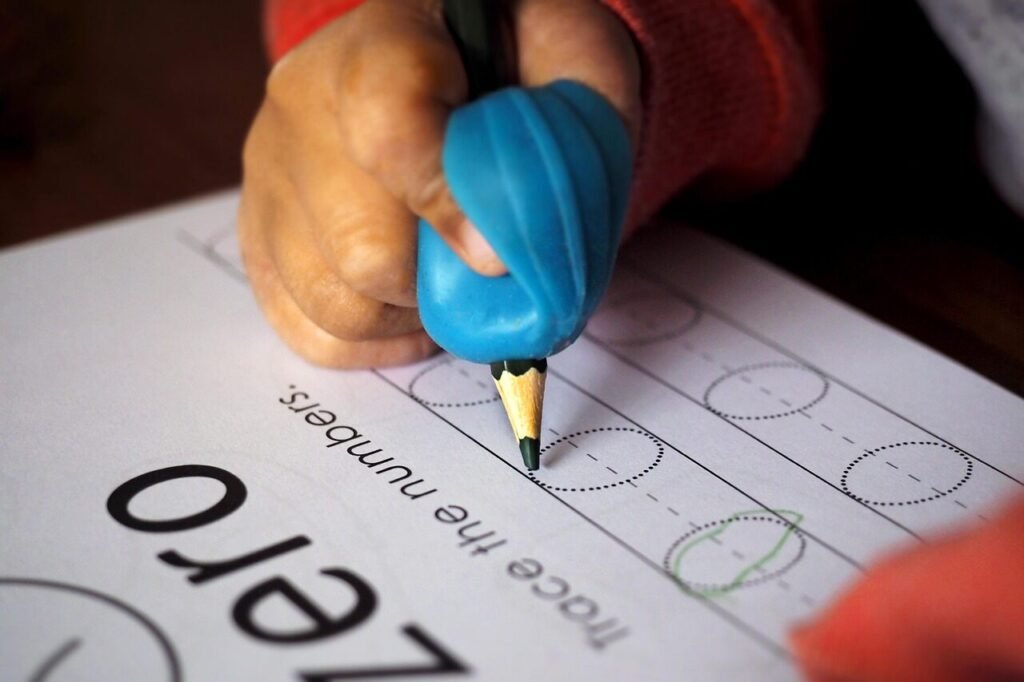
Arvind, a 38-year-old machine operator from Pune, lost two fingers in an industrial accident. He received a myoelectric finger prosthesis that responded well, but he struggled with precision. Picking up small screws or holding a delicate glass without breaking it was frustrating.
His physiotherapist introduced EMS as part of his rehabilitation. The focus was on the forearm flexor and extensor muscles that controlled the prosthetic’s sensors.
In the first month, Arvind did three 15-minute EMS sessions a week at the clinic, followed by practice tasks at home. By the third month, his grip control improved so much that he could handle even the smallest machine parts without errors. He now swears by EMS as a “shortcut” to better prosthetic control.
Neelam – From Struggle to Smooth Cooking
Neelam, a homemaker from Jaipur, lost part of her index finger in a kitchen accident. She received a cosmetic-mechanical finger prosthesis, which helped with basic tasks, but chopping vegetables and holding utensils was tiring.
When she heard about EMS from a Robobionics outreach camp, she was curious but skeptical. She began using a portable EMS unit at home, targeting her wrist and forearm muscles every alternate day.
Within weeks, she noticed less strain when cooking. Her grip became steady enough to handle slippery vegetables without fear of cutting herself. Today, she feels “like her hand is part of her again,” even with the prosthetic.
Ramesh – A Carpenter Back in Action
Ramesh from Nagpur lost his middle and ring fingers while working with a circular saw. His body-powered prosthetic was strong, but it required considerable effort to control cables and levers. After long days, his forearm muscles would ache.
His physiotherapist suggested EMS to strengthen the cable-pulling muscles. After 8 weeks of training, Ramesh reported not only better grip but also less fatigue by the end of the workday.
Now, he says he can work longer hours without compromising on precision, which has directly improved his income.
Kavita – Overcoming the Fear of Dropping Things
Kavita, a 29-year-old teacher from Lucknow, had partial finger loss from a road accident. While her prosthetic worked fine mechanically, her biggest problem was confidence. She often feared dropping chalk, markers, or even her mobile phone in class.
Through a rehabilitation program with Robobionics, she used EMS to train her forearm stabilizers and finger flexors. The result was not just physical—it was emotional.
Within two months, she was holding classroom tools without thinking twice. She says EMS gave her “trust” in her own hand again, something no mechanical feature alone could provide.
Abdul – A Fisherman’s Saltwater Challenge
Abdul, a fisherman from Kerala, faced a unique challenge: operating a prosthetic finger in wet, salty conditions. His muscles had weakened after months of limited work post-accident, and grip strength was poor.
His rehab team provided an EMS unit designed with waterproof electrodes so he could use it even in coastal humidity. After consistent use, Abdul could grip ropes and fishing nets with renewed strength, pulling in catches without relying on crew members for help.
Today, he combines EMS sessions with actual fishing tasks, making his training part of his daily work.
Common Themes from These Stories
Across these stories, some common threads emerge:
- EMS boosted not just physical performance but also confidence in daily activities.
- Improvements were noticeable within weeks but became life-changing over months.
- Pairing EMS with practical prosthetic use gave the best results.
What’s clear is that EMS is not just an add-on—it’s a bridge between what a prosthetic can do mechanically and what the user can achieve in real life.
Why These Successes Matter for India
In India, where many prosthetic users live far from advanced rehab centers, the ability to train muscles at home is a game-changer. EMS makes this possible.
It turns rehabilitation into something that fits into a person’s schedule—whether they’re a farmer, a teacher, or a carpenter. And because EMS devices are getting more affordable, this kind of progress is no longer limited to big-city hospitals.
The Science Behind Combining EMS with Prosthetic Adaptation
Understanding the Brain-Muscle-Prosthetic Loop

When you move a natural finger, your brain sends an electrical signal down your nerves, which triggers muscles to contract. These muscles pull on tendons, moving your finger bones. Sensors in your skin then send feedback to your brain, letting it adjust the movement in real time.
In a prosthetic system—especially a myoelectric one—the brain still sends signals to the remaining muscles. Sensors in the prosthetic detect these muscle contractions and convert them into mechanical movement.
But here’s the catch: if those remaining muscles are weak or underused, the signals they produce are small, slow, and sometimes inconsistent. That’s where EMS changes the game.
How EMS Strengthens the Signal Pathway
Think of the brain-muscle-prosthetic loop like a road. If the road is narrow and full of potholes, traffic moves slowly. Weak muscles are like that—signals pass through, but not efficiently.
EMS is like roadwork that widens and smooths the path. By stimulating the muscles directly and repeatedly, EMS:
- Activates more muscle fibers
- Strengthens the neuromuscular connection
- Increases the clarity of electrical signals picked up by prosthetic sensors
Over time, this means the prosthetic gets a stronger, cleaner signal, leading to smoother and more precise movements.
Muscle Fiber Recruitment: The EMS Advantage
Our muscles are made up of two main types of fibers:
- Slow-twitch fibers for endurance
- Fast-twitch fibers for quick, powerful actions
During normal daily activity, we mostly use slow-twitch fibers. But prosthetic control often benefits from activating both types, especially for quick grip adjustments.
EMS has the unique ability to recruit fast-twitch fibers early in the contraction, something regular low-intensity activity might not do. This balanced training improves both sustained grip (holding a cup for minutes) and rapid actions (catching a slipping object).
Why EMS Is Valuable During Early Prosthetic Training
After limb loss, the brain’s “map” of that limb changes. This is called cortical reorganization. Without training, the brain can lose some of its ability to control the remaining muscles effectively.
When EMS is introduced early, it keeps those muscle pathways active, preventing loss of control. Even before a user masters their prosthetic, EMS ensures the muscles are ready to deliver strong, reliable signals.
It’s like keeping an engine warm before a race—when it’s time to go, performance is immediate.
Improved Sensory Feedback Through Muscle Conditioning
While EMS doesn’t directly restore nerve-based touch, stronger and more responsive muscles can indirectly improve sensory feedback.
Here’s how:
- When muscles contract more accurately, users get better proprioceptive feedback (awareness of where their hand is in space).
- This improved awareness helps them adjust grip force without consciously thinking about it.
Over time, this makes prosthetic control feel more natural, even without a true sense of touch.
Endurance and Fatigue Resistance
One of the biggest challenges for prosthetic users is muscle fatigue. The muscles controlling the prosthetic often have to work harder than natural muscles because they’re compensating for lost structures.
EMS training increases muscle endurance by improving oxygen use and energy efficiency at the cellular level. This means a user can operate their prosthetic for longer periods without feeling sore or tired.
The Role of Frequency and Pulse Settings
Not all EMS is the same. Different frequency ranges affect muscles in different ways:
- Low frequencies (1–10 Hz) can help with relaxation and pain relief.
- Medium frequencies (20–50 Hz) are ideal for strength and endurance training.
- Higher frequencies (50–80 Hz) target fast-twitch fibers for quick, powerful movements.
When paired with prosthetic adaptation, a combination of medium and higher frequencies is often most effective—first building strength, then improving speed and precision.
Long-Term Neural Adaptation
The most exciting part about EMS and prosthetics is the possibility of long-term brain changes. Repeated stimulation and practice can lead to:
- Stronger neural connections to residual limb muscles
- Reduced “phantom limb” confusion in the brain
- Better integration of the prosthetic into the body’s self-image
This last point is crucial—when a prosthetic feels like part of the body rather than a tool, users tend to perform better and feel more confident.
Why the Combination Works Better Than Either Alone
Using EMS without a prosthetic can strengthen muscles, but it doesn’t teach those muscles how to control a device. Using a prosthetic without EMS can improve skill, but progress may be slow if the muscles are weak.
When combined, EMS builds the physical strength while the prosthetic provides the functional training. This dual approach accelerates adaptation, giving users faster results and more independence.
Future Possibilities for EMS-Integrated Prosthetics
Building EMS Directly into the Prosthetic
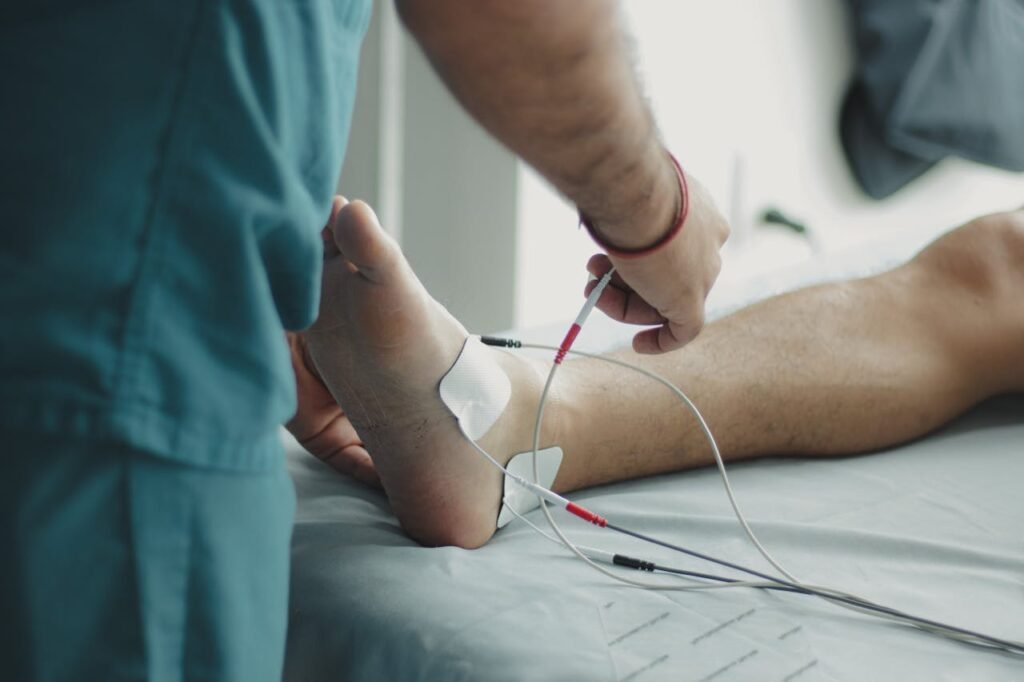
Right now, most EMS use with prosthetics involves an external device and separate training sessions. But what if the prosthetic itself could deliver EMS while you used it?
This would mean:
- Real-time muscle stimulation during tasks
- Strengthening and training while working or doing daily activities
- Less need for separate rehab time
For example, a farmer could be gripping a tool with their prosthetic, and micro-EMS pulses could be strengthening the controlling muscles at the same time.
Smart EMS with Adaptive Feedback
Future systems could combine EMS with sensors that detect muscle fatigue in real time. If the prosthetic senses that the user’s muscles are tiring, it could automatically adjust the EMS settings to maintain performance without overstraining the muscles.
This could be especially useful in rural India, where people often work for long hours without frequent breaks.
Affordable EMS Kits for Rural Users
At Robobionics, we see a future where every rural prosthetic user gets a simple, battery-powered EMS kit along with their device.
This kit would come with:
- Pre-marked pads for correct placement
- A basic training guide in local languages
- Suggested programs for strength, endurance, and coordination
The goal would be to make EMS as common and easy to use as a household tool, not just a clinic-based therapy.
Community EMS Stations
In areas where personal devices may be too costly initially, village health centers could host “EMS corners.” These would be small stations where prosthetic users come for short, regular sessions.
Trained health workers could supervise, ensuring correct use and encouraging more people to try EMS alongside prosthetic adaptation.
Integration with Gamified Training
One exciting direction is combining EMS with virtual or gamified prosthetic training apps. Users could control an on-screen game with their prosthetic, while EMS stimulates muscles in sync with the movements.
This would make training more engaging, encourage longer practice times, and appeal to younger users especially.
Research and Data for the Indian Context
Most EMS-prosthetic research today comes from Western countries. The next step is large-scale studies in India, considering:
- Our rural and urban work environments
- Local muscle use patterns based on occupation
- Climate factors affecting skin-electrode contact
- Cost and access challenges unique to our population
By collecting this data, we can refine EMS integration to truly suit Indian users.
Conclusion: A Stronger Grip on the Future
For many prosthetic users, getting the device is only the first step. The real journey is learning to use it with precision, confidence, and ease.
EMS offers a way to speed up that journey. By strengthening the muscles that control a finger prosthetic and sharpening the signals they send, EMS helps users move from “just using” their device to mastering it.
The combination isn’t magic—it’s science, patience, and practice working together. But when done right, the results can be life-changing. Farmers can work longer without strain. Carpenters can cut and shape wood with accuracy. Homemakers can cook and serve without fear of dropping anything. Teachers can hold a pen or chalk with confidence in front of a class.
At Robobionics, we believe EMS will soon be as common in prosthetic training as basic exercises are today. Our vision is a future where every user—whether in a city apartment or a remote village—has the tools to build their grip strength, improve control, and live life on their own terms.
Grip is more than a physical action. It’s a way of holding onto independence, dignity, and self-belief. And with EMS plus prosthetics, that grip can be stronger than ever.
Book Your Consultation with Robobionics to explore how EMS-supported prosthetics could help you or someone you know regain not just a hand, but full control over it.



